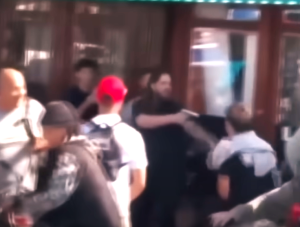An incident involving a liquor store employee in Oakland, California, has sparked significant debate surrounding self-defense laws and media coverage of the event. The incident occurred on a Saturday afternoon when a group of over 100 teenagers, described as predominantly Black youths on bicycles, surrounded the Golden Hours Liquor Store. According to the store employee, identified as Robert, the group became violent, with individuals attempting to loot the store and physically assault him.

Viral Video Captures Event
A video of the event quickly circulated online, raising concerns about the rising crime rates in Oakland and how individuals should respond in such situations. The viral footage, which was shared across multiple platforms, shows a large crowd gathering outside the store. At one point, Robert is seen pulling out a firearm in response to what he described as an attack. He later explained that he felt the need to arm himself after being punched by individuals in the group and having someone reach for his gun. The video clearly captures him pulling the gun, but local news reports downplayed the attack, referring to Robert’s account as something he “claims” occurred.
The ambiguity in the local news coverage angered many who believed that the media failed to accurately portray Robert’s actions as self-defense. According to additional footage shared on social media, not only was Robert attacked, but he was also struck multiple times, leading to his decision to draw the firearm. Despite this, the local media continued to describe the event in vague terms, avoiding direct acknowledgment of the attack and referring to the group as “teens.”
Media Coverage Raises Questions
The media’s portrayal of the event has led to significant criticism. Many believe the local news failed to present the full scope of the incident and instead focused on the fact that Robert, a white employee, used a gun in self-defense against a group of Black teenagers. The coverage sparked accusations that the news report was deliberately vague and downplayed the actions of the mob while highlighting Robert’s decision to pull a firearm. Critics argue that the media’s choice of language, such as describing the group as a “large gathering” or “teens,” created a misleading narrative that ignored the criminal actions of the group.
Robert’s Account
In an interview, Robert explained that he did not intend to harm anyone when he drew his weapon. He stated that after being struck by the crowd and feeling that his gun was in danger of being taken, he acted to protect himself. Robert said that the crowd became violent, and he was repeatedly punched and attacked before he made the decision to arm himself. He added that members of the group were attempting to steal from the store, and some even pulled out knives. Once he drew the gun, the crowd quickly dispersed.
Robert emphasized that he only resorted to using his firearm after other attempts to de-escalate the situation failed. He also pointed out that drawing the gun likely prevented further violence, including potential looting of the store and additional attacks on him. However, despite his efforts to protect himself and the store, Robert was detained and questioned by the police while no arrests were made among the group of teenagers.
Ongoing Investigation and Community Reactions
The incident has highlighted the growing concerns among Oakland residents and business owners about rising crime in the area. Other local business owners, such as Phillip Gums, who owns a store nearby, have expressed frustration with the frequent vandalism and robberies they face. Gums noted that his store had been shot at and vandalized multiple times, driving away customers and hurting his business.
Oakland City Councilmember Noel Gallo called for increased police presence and the reactivation of city surveillance cameras, which had been turned off for unknown reasons. Gallo believes that more visible law enforcement and monitoring could help curb the rising crime rates in the city. However, the Oakland Police Department’s public statements advising residents not to engage criminals have been met with skepticism. The police urged residents to act as “good witnesses” rather than confront criminals, but critics argue that this approach leaves business owners and residents vulnerable.
Concerns Over Potential Legal Action
The incident has also drawn attention to the potential legal consequences Robert could face for defending himself. Some fear that Alameda County District Attorney Pamela Price, known for her progressive stance on criminal justice, may pursue charges against Robert for using a firearm, despite the clear evidence that he was defending himself from an attack. Critics of Price argue that her policies prioritize criminals over law-abiding citizens and that Robert’s case may become an example of this perceived bias.
In conclusion
The Oakland incident has sparked significant discussion about self-defense rights, media bias, and the responsibilities of law enforcement in protecting citizens and business owners. As the investigation continues, many are watching closely to see if Robert will face charges or if the focus will remain on addressing the crime issues plaguing the area.


